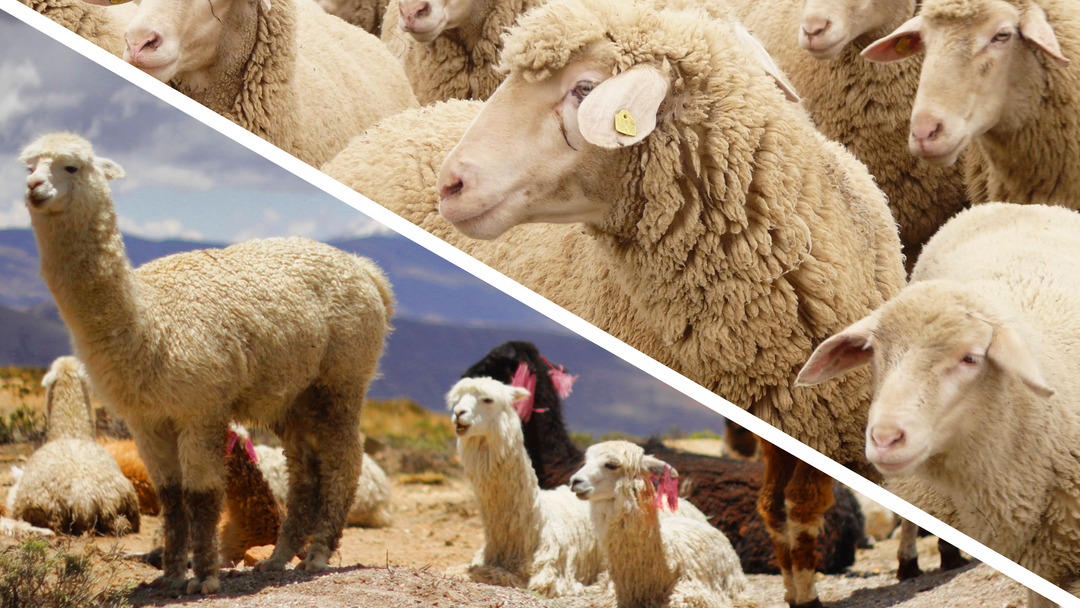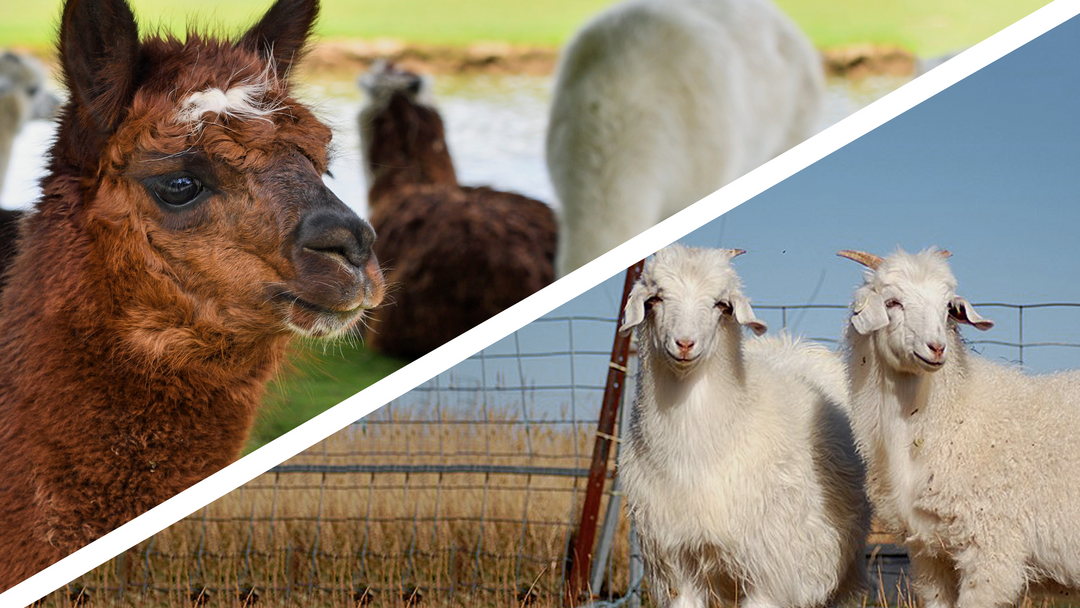The exquisite pleasures of life are often subtle, hidden in nuances that only the discerning eye can detect. This discussion takes us to the Andes, a region of breathtaking beauty and home to two remarkable creatures: the alpaca and the llama. Here, a multi-faceted portrait unfolds, embodying both aesthetics and function. But what really sets these two animals apart, and why should you care?
Table of contents
The majestic origin

The Andes have more to offer than just their enchanting landscapes. They are also home to alpacas and llamas, animals that represent the heart of indigenous cultures. Each animal represents a certain finesse, a unique quality that makes it worthwhile to look more closely at their differences.
Genetic relationship
Both animals belong to the camel family, but they are not just distant cousins in the animal world. Rather, they are closely related and share many similar characteristics. It is important to emphasise that the llama is often considered the "bigger brother" of the alpaca. Although they are both wonderful examples of adaptation and survival in the high altitudes of the Andes, they have some striking differences, both in appearance and behaviour.
Aesthetics and Attitude: A Comparison

Those who appreciate aesthetics will immediately recognise that alpacas and llamas, while similar, are distinctly different.
The Appearance
Lamas are often larger and more robust than alpacas. Their ears are elongated and banana-shaped, while alpacas tend to have smaller, spear-shaped ears. Their facial features are also different: llamas have a longer face, alpacas a shorter, almost teddy bear-like face.
The wool
For lovers of luxurious textiles, the question naturally arises: which wool is better, that of the alpaca or that of the llama? Alpaca wool is known for its fine, soft fibres, which are used in the manufacture of high-quality garments. Llama wool is coarser but is also prized, especially for its resilience.
The behaviour
Last but not least, we cannot ignore the issue of elegance in behaviour. Although both animals are capable of spitting, they do so only rarely and usually only when they feel threatened. In this context, one could say that the alpaca is rather the more reserved and calm of the two animals.
The preferences of the connoisseurs

If one had to choose an animal, the alpaca would often be the choice of connoisseurs. This is not only due to the quality of alpaca wool, but also the temperament of the animal itself. The special relationship that many people develop with alpacas is often the key to the deep affection they feel for these animals.
It would be unwise, however, to simply dismiss the llama as the "less refined" of the two animals. Llamas have their own charm and are wonderful load carriers, often used on treks in the Andes. Their rugged nature makes them excellent companions for adventures in harsh environments.
When it comes to which wool meets the higher standards, alpaca wool often comes out on top. Its soft, luxurious fibres are in high demand in the fashion and textile industry and are particularly suitable for garments worn directly against the skin.
Alpacas and llamas in Andean culture
The inclusion of these remarkable animals in the lives of Andean people is not merely a symbol of tradition, but also an expression of deeply rooted values and beliefs. Andean culture has always had a special relationship with alpacas and llamas that goes beyond mere utilitarianism.
Spiritual Meaning
In Andean culture, both alpacas and llamas are considered sacred animals, closely associated with the land and its people. Their importance goes beyond their wool and their role as burden bearers. They are part of spiritual ceremonies and are often seen as bridges between the spiritual and physical worlds.
Practical applications
Lamas have made a name for themselves as reliable load carriers in the high altitude areas of the Andes. Their robustness and endurance make them ideal companions for longer journeys. Alpacas, on the other hand, are particularly valuable because of their wool. This wool is not only used to make clothing, but is also integrated into various cultural artefacts, which are an important part of the cultural heritage of the Andes.
The Contemporary Influence

The fascination with alpacas and llamas has made waves far beyond the borders of the Andes in recent years. Alpaca wool in particular has managed to secure a place for itself in the world of luxury fashion. Many renowned designers have recognised the extraordinary properties of alpaca wool and incorporate them into their collections.
An Investment in Quality
For the modern connoisseur, investing in alpaca products represents an investment in quality. The wool is not only extremely soft, but also resistant to wear. Its unique thermal properties make it an excellent choice for any season.
A piece of Andean culture in modern life
The attraction of these animals and their wool is not just about aesthetics or luxury, but also about the possibility of integrating a piece of this rich and diverse culture into our modern lives. It is about finding a deeper connection to the elements that enrich our lives, whether through the selection of exquisite fabrics or through an appreciation of the cultural significance behind these remarkable animals.
The Quintessence of Alpaca and Llama Wool
When you explore the world of alpacas and llamas in depth, it becomes clear that these animals are more than just charming creatures; they are synonymous with quality and sustainable luxury experiences.
Alpaca Wool Versus Other Natural Products
The choice of alpaca wool over other natural products is a clear expression of the desire for the extraordinary. Compared to conventional wools, alpaca wool is known for its hypoallergenic properties, making it an ideal choice for people with sensitive skin. It also outperforms other natural fibres in terms of softness, warmth and durability.
Creations and Applications
The versatility of alpaca wool is reflected in a range of high-quality products, from clothing to home textiles. In our alpaca shop, you'll find everything from knitwear to exquisite accessories to enhance your home. For discerning tastes, there are even specialised applications that make the most of the wool's unique properties.
The Heritage and the Future
Alpacas and llamas are not only an indispensable part of Andean culture, but also increasingly a symbol of global, sustainable luxury. In today's world, where everything is in flux, the constant of quality that these animals represent remains. This quality is ensured by the careful breeding and respectful treatment of the animals, a tradition that has continued for centuries.
Closing Thoughts
At a time when the importance of quality and authenticity in life is becoming increasingly important, alpacas and llamas represent a compelling example of the best of both worlds. It is more than a choice of style; it is a choice of lifestyle. Whether you choose to wear alpaca clothing or expand your knowledge of alpacas and their culture, you're investing in an experience that's as profound as it is luxurious.
The allure of these extraordinary animals and their products is an endless source of inspiration and prosperity, both material and spiritual. Once experienced, the fascination with alpacas and llamas is sure to be a lifelong companion, enriching one's life in many ways.
Frequently asked questions about the mystery of alpaca and llama
The magic that comes from alpacas and llamas is not only alluring, but also raises numerous questions. These FAQs serve as your personal resource to broaden your horizons and delve deeper into the world of these enchanting creatures
What makes alpaca wool hypoallergenic?
Alpaca wool has a unique fibre structure that allows for the absence of lanolin, a substance often found in other animal wools that can trigger allergies. This makes the wool an excellent choice for sensitive skin.
How do alpacas and llamas differ in their behaviour?
While alpacas tend to be shy and quiet, llamas are more alert and sometimes aggressive. Llamas are often used as guards for alpaca herds. It is rarer for alpacas to spit, while llamas are known to do so as a defence mechanism.
Why is alpaca wool more expensive than other wool?
The quality of alpaca fibre, especially the finer varieties such as baby alpaca, and the limited annual fleece output per animal, make alpaca wool a precious resource. The wool is often handpicked and goes through several quality controls, which justifies its higher price.
What are the primary uses for llama and alpaca wool?
Both types of wool are found in a range of luxury products, from clothing to home textiles. However, alpaca wool is often used for finer garments, while llama wool is found in more robust applications such as carpets and blankets.
Is the wool from alpacas and llamas sustainable?
Yes, the wool from both animals is a sustainable resource. Alpacas and llamas have a small ecological footprint and the wool is biodegradable. In addition, alpaca and llama farming often supports local communities and contributes to the preservation of traditional ways of life.
How is the high quality of the wool ensured?
The quality of wool depends on many factors, including the breed of the animal, its diet and the care taken during shearing. Both alpaca and llama wool undergo rigorous quality testing to ensure that only the best fibres are used.
How do I best care for my alpaca products?
Alpaca wool requires less care than other wools. It is stain resistant and needs to be washed less often. Hand washing or a gentle wool programme in the washing machine is usually sufficient. It is recommended to dry flat and avoid direct sunlight.











